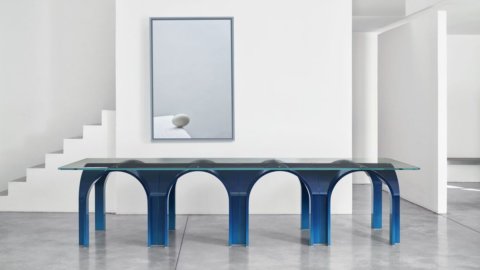This elegant new work by Antonio De Marco – Lagoon, homage to Venice – once again confirms the specificity of the Italian furniture design namely the close relationship established since the 50s between industry and architecture. After the war, in fact, a group of young architects who had recently graduated from the Milan Polytechnic had begun to design and create the first examples of contemporary design furniture. While industrial design in other countries has always indicated the technical work of "designers" trained to work in factories, in Italy it has had a much broader and culturally open development thanks to the fact that architects have mainly designed houses.
Almost all the Brianza furniture makers soon understood that in order to modernize their production in style and respond to the growing demand for furniture in booming Italy, it was necessary to make a leap in quality. And the architect immediately assumed the role of promoter, commercial consultant, experimenter of technologies and often also a friend of the furniture maker.
It was not by chance that the historian was the one to kick off contemporary Italian industrial design XNUMXth Milan Triennale with the exhibition “The shape of profit”, set up by the most famous of the Italian urban planning and architecture studios, the BBPR (Banfi, Barbiano di Belgioioso, Peressutti and Rogers). This is to explain that very often there was a happy osmosis between Great Architecture and Italian design which even included a humble moka, the award-winning one among the many examples: the Conic designed by the great Aldo Rossi for Alessi.
There have been so many examples and even among today's young designers this symbiosis that Antonio De Marco cultivates with very refined projects like this one shines through. “This project is a tribute to the city of Venice – he declares – to its fragility and at the same time an incredible strength. The geometry recalls that of the many tunnels in the city with the typical cross vaults. A classic architectural element is transformed into elegant and refined furniture. Inspired by the Venetian loggias, it is configured in several linked vaults that support the glass top”.
In the presentation of Antonio De Marco's study there is also another all-Italian specificity, that of a hybridization between culture and craftsmanship, the Italian one, which, always experimenting with innovative technologies, maintains an inimitable dexterity and attention to detail. An example of this inimitableness? Federlegno Furniture recently communicated that the very country that has built much wealth on counterfeiting, China, does not copy but import Italian furniture is overwhelming, with an increase in 2021 of almost 30 percent on 2020 and 11,8 percent in 2020 on 2019.
Again De Marco underlines that he is deeply attached to the values of this inimitable technical craftsmanship: “This project is entirely designed and manufactured in Italy by expert craftsmen in the furniture world, and I always choose to work with the best craftsmen to have pieces that can last over time. The value of my objects comes from their hands”.
If you want to learn more about this way of working, just look De Marco's creations: they feature very strong and innovative technological elements such as the transformation of the very original Atollo for Roberti Rattan, a versatile day-bed inspired by the world of catamarans. “A large net stretched inside a metal structure – reads the presentation – a flexible system both in configurations and in use by the person; an informal seat designed for maximum relaxation”. The Humidor cabinet is also transformable and original, for cigars made in a limited series to celebrate the fiftieth anniversary of the Trinidad brand of DeArt Habanos. Made of ebony, brass and mother-of-pearl inlays, it opens and closes with compact movements and shapes.





